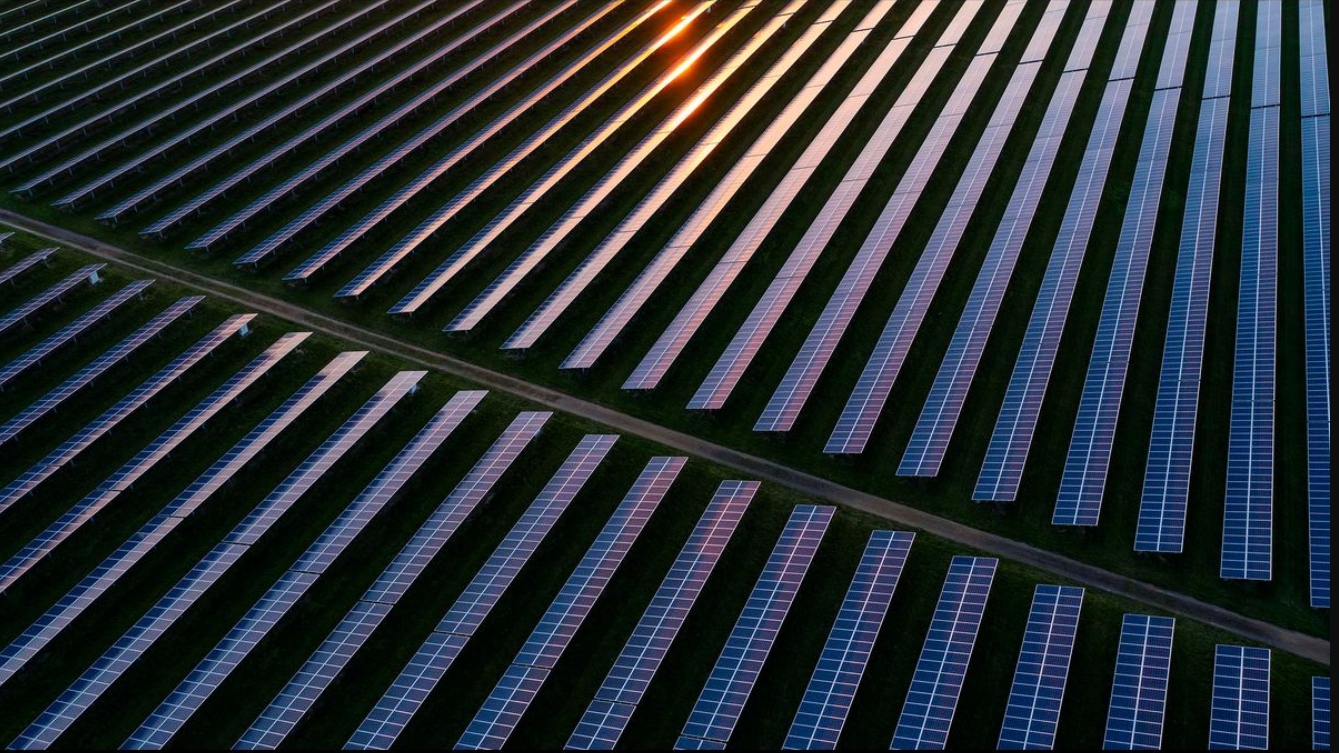The cost of solar power: how low can we go?

剑桥大学化学工程与生物科技系的山姆·斯特兰克斯(Sam Stranks)教授正在开发新一代太阳能电池技术,这将会进一步降低可再生能源的价格。
Professor Sam Stranks ,Cambridge’s Department of Chemical Engineering and Biotechnology,is developing next-generation solar cell technology, which could drive down renewable energy prices even further.
尽管人们可能觉得围绕气候变化的新闻似乎总是消极负面的,但也有一些显著的亮点。其中最亮点就是太阳能。
Although it may feel as if the news around climate change is unrelentingly negative, there are some remarkably bright spots. One of the brightest is solar energy.
仅在过去的十年间,太阳能电池的成本下降了90%。四十多年来,在许多国家,太阳能已经从最昂贵的电力来源之一转变为最便宜的电力来源。但我们还有很长的路要走。
In just the last ten years, the cost of solar cells has fallen by 90%. Over four decades, solar has transformed from one of the most expensive electricity sources to the cheapest in many countries. But we still have further to go.
为了在全球实施和推广太阳能,我们需要让它比目前太阳能电池的主要材料硅更便宜、更高效。实现这一目标的方法之一,就是用比硅能利用更多太阳光谱的材料制造太阳能电池,从而提高其效率。。
To implement and expand solar energy worldwide, we need to make it cheaper and more efficient than silicon, the dominant material used for solar cells today. One way to do this is to make solar cells from materials that can use more of the solar spectrum than silicon can, which would make them more efficient.
最有希望取代硅的是称为钙钛矿系列的材料。钙钛矿比硅更便宜,而且可以制造出表现优异的太阳能电池:它们的总能量输出通常可以达到或(在多层“串联”装置的情况下)超过传统的硅太阳能电池。然而,钙钛矿太阳能电池还不够稳定,不能保持常年高性能工作。
The most promising replacement for silicon is a family of materials called perovskites. Perovskites are cheaper than silicon and make excellent solar cells: their overall energy output can often meet or – in the case of multi-layered ‘tandem’ devices – exceed that of traditional silicon solar cells. However, they are not yet stable enough to operate at high performance for many years.
最有希望取代硅的是称为钙钛矿系列的材料。钙钛矿比硅更便宜,而且可以制造出表现优异的太阳能电池:它们的总能量输出通常可以达到或(在多层“串联”装置的情况下)超过传统的硅太阳能电池。然而,钙钛矿太阳能电池还不够稳定,不能保持常年高性能工作。
The most promising replacement for silicon is a family of materials called perovskites. Perovskites are cheaper than silicon and make excellent solar cells: their overall energy output can often meet or – in the case of multi-layered ‘tandem’ devices – exceed that of traditional silicon solar cells. However, they are not yet stable enough to operate at high performance for many years.
在剑桥大学化学工程与生物科技系的实验室里,山姆·斯特兰克斯教授正在研究钙钛矿随时间退化的情况,以提升其效率和稳定性。
In his lab at Cambridge’s Department of Chemical Engineering and Biotechnology, Professor Sam Stranks is studying how perovskites degrade over time, to improve their efficiency and stability.
斯特兰克斯的团队使用专业的显微镜技术来研究钙钛矿中的缺陷,从而能够获得微米级甚至纳米级的高精度图片。他们还模拟了阳光下钙钛矿装置的工作原理,在人造阳光下连续测试数千小时,或在通过提高温度或湿度水平的高压条件下测试。这些测试有助于他们了解装置是如何以及何时损坏的。
Stranks’ team uses specialised microscopy techniques to study defects in the perovskites, enabling them to get highly detailed pictures at the micro- or even the nanoscale. They also simulate how perovskite devices work under sunlight, testing them continuously for thousands of hours under artificial sunlight, or under high-stress conditions by increasing temperature or humidity levels. These tests help them understand how and when the devices break.
然后这些研究结果将被带回他们的制造实验室,科研人员对材料的成分或分层方式进行改变,以提升材料的性能。
These results are then taken back to their fabrication lab, where changes can be made to the composition of the materials, or how they are layered, to improve performance.
斯特兰克斯说;“由于钙钛矿装置的造价低很多,因此它们可能不需要像硅基电池一样长的使用寿命就能进入某些市场。但是为了发挥其最大潜能,钙钛矿太阳能电池需要可靠运行至少十年或更长时间。”
“Because perovskite devices are much cheaper to produce, they may not need to have as long a lifetime as their silicon counterparts to enter some markets,” said Stranks. “But to fulfil their ultimate potential, perovskite solar cells will need to reliably operate for at least a decade or more.”
钙钛矿的一个奇特之处在于它们“杂乱”的结构,这和高度有序的硅晶体非常不同。这种混乱的结构会导致材料上的缺陷,形成微小的“陷阱”,通常会降低性能。
One of the curiosities of perovskites is their ‘messy’ structure, which is very different from highly ordered silicon crystals. This messiness causes defects in the material that lead to tiny ‘traps’, which typically reduce performance.
在2022年发表于《自然》(Nature)的一篇论文中,斯特兰克斯和他的共同作者指出,这些陷阱可能是提高钙钛矿太阳能电池寿命的关键。尽管有这些陷阱,钙钛矿太阳能电池的性能仍能媲美传统的硅基太阳能电池。
In a 2022 paper published in Nature, Stranks and his co-authors showed that these traps could hold the key to improving the longevity of perovskite solar cells. Even with the traps, perovskites show a similar efficiency to silicon.
但通过调整钙钛矿的化学成分和钙钛矿薄膜的形成方式,斯特兰克斯和他的同事们发现是有可能阻止其中一些陷阱的形成。他们的研究结果表明,有可能在提升钙钛矿寿命的同时进一步提高其效率,这将打开钙钛矿太阳能电池的商业化生产的大门。
But by tuning the chemical composition, and how the perovskite film forms, Stranks and his colleagues showed that it’s possible to prevent the formation of some of these traps. Their results suggested that it’s possible to improve the efficiency of perovskites even further while improving longevity, opening the door to commercial production of perovskite solar cells.
钙钛矿是用液体墨水制备的,只需简单的打印工艺即可生成材料的薄膜。在柔性甚至透明的材料上大规模打印钙钛矿太阳能电池能够开辟出广泛的应用领域:例如可以在硅太阳能电池板上叠加透明薄片,可以将太阳能电池包裹在建筑物或汽车顶部,或做像卷轴一样展开,从而降低屋顶太阳能发电装置的安装成本。
Perovksites are prepared in liquid ink that is simply printed to produce a thin film of the material. Printing perovskite solar cells onto flexible or even transparent materials at scale could open up a huge range of applications, such as transparent sheets that could be layered on top of silicon solar panels, solar cells that could be wrapped around buildings or on top of cars, or rolled out like a spool, reducing installation costs of rooftop solar power.
斯特兰克斯表示:“钙钛矿太阳能电池的另一个优势是它可以在没有硅加工基础设施的国家制造。从长远来看,硅基太阳能电池很便宜,但是它需要大量的前期资金投入才能开始运作。但对于钙钛矿太阳能电池,由于它们很容易打印、使用的材料要少得多,因此可以降低初始成本。钙钛矿太阳能电池为寻求向太阳能过渡的中低收入国家提供了切实可行的选择。”
“Another strength of perovskite devices is that they can be made in countries where there’s no existing infrastructure for processing silicon,” said Stranks. “Silicon solar cells are cheap in the long term, but require a substantial initial capital outlay to begin processing. But for perovskites, because they can be printed so easily, using far less material, you lower that initial cost. They offer a viable option for low- and middle-income countries looking to transition to solar energy.”
斯特兰克斯是斯威夫特太阳能股份公司(Swift Solar)的联合创始人,该公司致力于开发高性能钙钛矿太阳能组件,以满足全球能源需求的。基于斯特兰克斯在剑桥实验室取得的研究进展,这些成果使钙钛矿在效率、寿命和稳定性方面取得了切实的提高。
Stranks is a co-founder of Swift Solar, a company dedicated to developing high-performance perovskite solar modules scaled for global energy needs. The company builds on the advances made in Stranks’ Cambridge lab, which have resulted in tangible enhancements in perovskite efficiency, lifespan and stability.
斯特兰克斯说:“我每天起床的动力是创造改变的机会,特别是在应对气候变化等全球性挑战方面。我们在实验室开发的技术能为解决社会最严峻的挑战带来巨大影响,这让我非常兴奋。”
“What gets me up each day is the opportunity to make a difference, particularly around global challenges like climate change,” said Stranks. “It’s really exciting to me that through the technology we develop in the lab, we could make a huge difference to society’s most pressing challenge.”

 English
English 中文
中文

